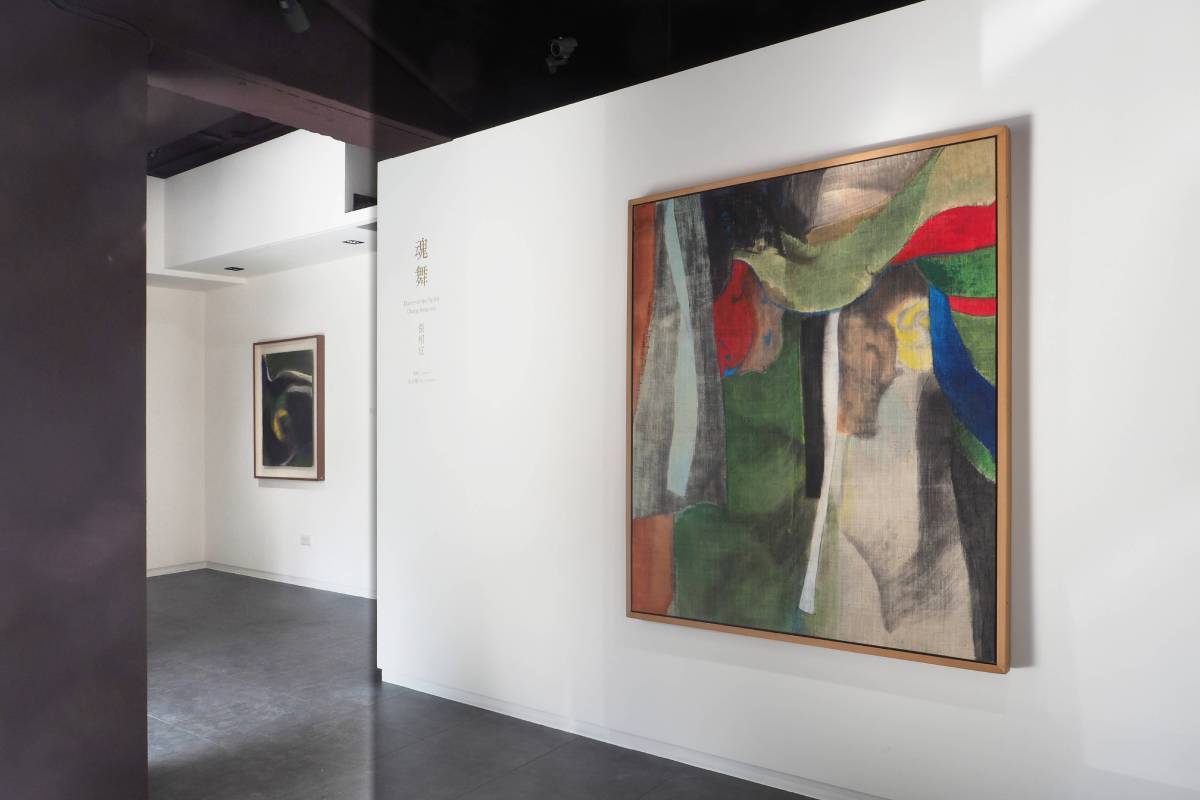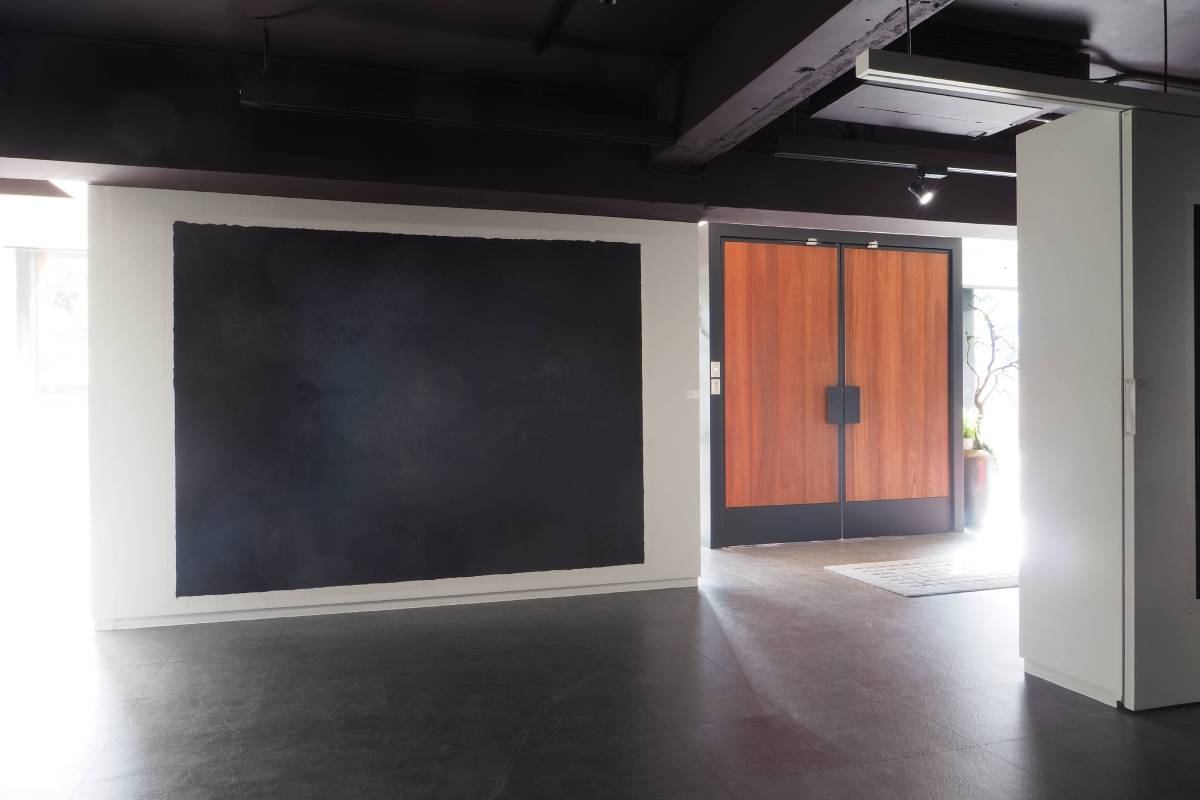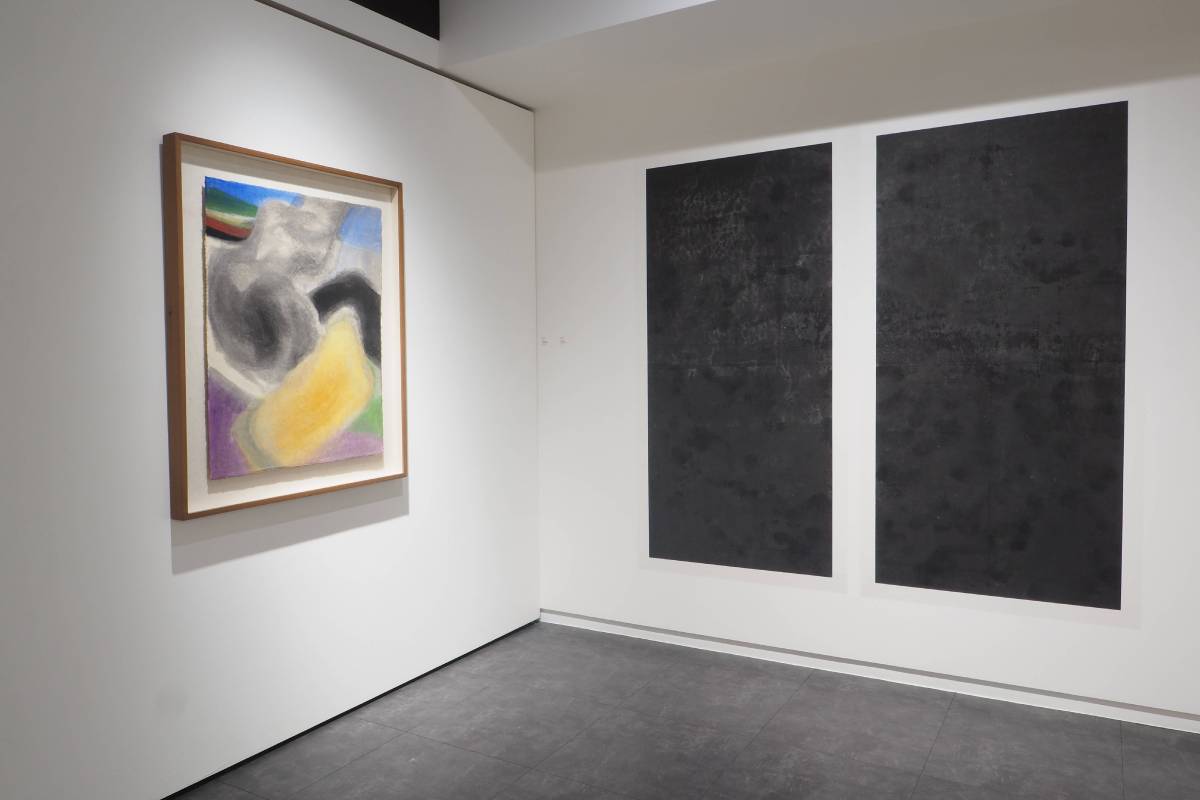赤粒藝術
【魂舞】張相宜藝術作品的世界

-
魂舞:張相宜藝術作品的世界
文貞姬 國立臺南藝術大學副教授
我一直這麼認為,時常出現在張相宜藝術作品世界中「魂」的形象,是以一種動態生命力的樣貌出現,且試圖跨越生與死的界線。1940年,第二次世界大戰結束後,離韓半島解放前五年,張相宜出生於今日北韓的開城,她的藝術創作,伴隨著歷史上南北韓的分裂,一同開展,如此成長的歷史背景,成為張相宜往後創作的基礎與動力來源。就我所觀察到的張相宜,從進入大學後,即展開藝術家創作生涯,迄今(2019年)長達60年,今日當我們回過身,重新審視張相宜將近一生的創作歷程,可以說她的藝術世界中,作為連結生者與死者,恰似靈媒角色的「魂軸」,佔據極重要角色地位。今日,張相宜的藝術作品內,透過身體作為媒介,所展現出來的舞蹈,欲傳達給觀者的是靈魂的訊息,至少就我所知,在她將近40年間所陸續創造出來的作品,其中透過微風、山陵、天空、浮雲等,皆欲傳達出生者與死者的魂魄,而此藝術表現手法,我們還可以進一步觀察到,張相宜透過間接、次要的媒介,加以還原出自身創作的源泉。
張相宜的創作,善用微風、天空與浮雲等自然現象,來表達出靈魂的形象,藉此傳遞出消逝的存在,誕生出動態嶄新的精神性舞蹈,此般精神性的舞蹈,時常出現在她的作品中,為藝術家透過自身的身體連結靈魂,同時也展現出試圖與另一個世界對話的可能,揭示出世上萬物於存在與消逝中,不停搏鬥的過程,易言之,張相宜畫面中的女性舞蹈者,乃是作為她與他者對話,同時也是藝術家超脫自身內面的象徵媒介。
繼之,張相宜的作品,於1980年代左右,清楚地讓人看見她使用舞蹈來交流生者與死者世界的題材,且她於其中採用韓國傳統舞姿、顏色與原型。尤其是張相宜於1989年所創作的〈開城到首爾〉,她透過個人成長史之外,同時交纏著韓國史史詩般的敘事,所創作出來的作品,我們在此壯闊的畫面中,明顯可見舞者的舞裳,強烈地傳達出1950年代南北韓戰後,生者與死者、國土分裂的悲痛,而張相宜透過畫面中舞者生動的舞裳,更加昇華其悲痛。張相宜於此創作階段,以傳統韓國式舞蹈的原型與色彩,陸續創作出〈靈魂〉(1989年)等代表性作品,
作品透過流動性線條,描繪出原初性身體與靈魂合而為一的造型。
特別是上述〈靈魂〉一作中,張相宜並非創作於紙上,而是在棉布等編織物上作畫,完全異於紙或緋緞等材質,呈現不一樣的藝術手法。而眾所皆知的,韓國傳統服裝製作多使用棉布,連同死者壽衣也是這般。張相宜使用此手法與素材,無疑地是想藉此傳達出死者的魂魄及其莊嚴性,就此看來,我們也可將張相宜選擇不使用紙張,而改用棉布創作的行為,視為她本身創作生涯中,實驗性表現藝術手法的階段,但不容小覷的是,張相宜除了在棉布上實驗其筆墨,也在其中試驗製作衣服材料的棉布,其物質纖維組織的極限,以便探討出更多筆墨變化。而此實驗性手法,從張相宜1980年代,開始使用傳統式韓國壽衣進行創作,試圖傳達出靈性世界觀外,也藉由跳著韓國傳統舞蹈之女舞者的舞裳,完美地再現出肉身與精神合而為一的狀態。
而在韓國「非定形藝術」(art informel)抽象化,以及現代化藝術發展過程中,張相宜利用棉布、麻布等物質性物質,抽象化「墨」的實驗手法,探究物質性變化之徑,此點呈現在她的1989年〈靈魂〉的作品內。易言之,張相宜利用異物質(植物、棉布等纖維組織)來取代傳統紙張作畫,直接面對物性,同時也有呼應1980年代韓國民主化口號中,回歸傳統之姿。另一方面,張相宜在1990年代後半葉,更是以靈魂為主題,創造出一系列〈花朵與靈魂〉的作品,意在慰靈韓戰中數以萬計犧牲的死者、士兵們,她於此一系列作品內,透過墨描繪出不同的戰爭場景,還在畫面上增添上盛開的花朵,其中包含有連結他者彼岸世界的意涵。一言以蔽之,〈花朵與靈魂〉系列作品中的墨,乃是作為精神性的魂與新生之生命力的原初交會所在。
張相宜藝術作品中,水墨與彩墨呈現出二分變奏狀,從此開創出朝向墨質自身世界之路。1963年,張相宜畢業後,作品獲得藝術公募大賞,而從那時開始,張相宜正式成為一名畫家,進行她的水墨抽象創作,同時她也加入墨林會,積極參與畫會活動。張相宜是一位跳脫傳統東洋畫範疇,朝向半抽象乃至抽象的藝術家,其過程中,「魂舞」可說是一貫性地出現在她此階段的藝術創作之中。
大約與張相宜使用「魂舞」為主題相近時期的1971年,其作品獲得韓國日報社主辦的第二屆現代藝術大選「最優秀獎」,以此更加確定她的藝術成就與努力。而在1960年代末至1970年代,正是韓國現代藝術發展階段,抽象畫開拓出許多藝術新視野與繪畫的多重可能性。換句話說,張相宜的抽象畫在當時畫壇極具轉折性與影響力。然而,提到韓國現代化藝術,我們不得不提當時在新聞出版界內,大力鼓吹抽象畫的金煥基,他藉由舉辦公募展,推動抽象畫的成長,促成抽象畫之蓬勃發展。而張相宜的作品也在第二屆公募展內獲得好評。
張相宜藝術作品中,抽象是從半抽象發展而來,透過水墨與彩墨二重反覆交織,乃至新的抽象畫境界。「魂舞」便是她典型的代表性藝術主題。此次展覽,主要展出張相宜最新的創作,即她透過水墨與彩墨二重變奏,讓觀者看到畫面中舞者,藉由生動的舞蹈,揭露出黯淡太初世界,來到深層畫面。特別是〈光之軸〉(2019年)此一作品,讓我們看到張相宜透過探討墨色之根源,彷彿欲召喚出自由靈魂,這象徵她的創作靈魂,讓人們一窺張相宜迄今一生藝術創作之生命力與所欲前往之路。
最後,張相宜近60年來的藝術創作生涯中,最近這十幾年間的新作中,我們看到其創作精神的律動性線條反覆出現,象徵她返回自身的自然觀,她的作品內,透過微風、天空、雨,與人的身形姿態等圖像,作為一種訊息,欲傳達給觀者她自身創作精神的完結,與所開創藝術新的一頁,張相宜的「魂舞」,即是張相宜這位藝術家之魂,同時也是她的生死觀,更是她試圖在自然觀內,欲開拓的嶄新藝術之路,也就是「魂舞」所具有之意涵。
Dance of the Spirit: Chang Sang-Eui’s World of Artworks
Moon, Junghee
Associate Professor, Tainan National University of the Arts
The image of “soul” often present in the world of Chang Sang-Eui’s works of art, I always think, emerges in a dynamic state full of vitality, striving to cross the boundaries of life and death. In 1940, following World War II, or five years before the Korean Peninsula was liberated, Chang was born in the North Korean city now known as Kaesong. Her artistic career has unfolded along with the historical division between North and South Korea. The historical background in which she grew up serves as a foundation and stimulus for her later artistic creation. As far as I know, her artistic life began right after she studied in university, and has lasted as long as sixty years now (2019). If taking a look back and reviewing the course of her almost lifelong career as an artist, we might say that the “axis of the soul,” which is akin to a psychic medium who connects the living and the dead, occupies a pivotal role in her artistic world. The message of the soul is what Chang tries to convey to the viewer through dance with the body as a medium in her artworks. At least from what I have observed in her works spanning nearly 40 years, she has sought to portray the breeze, mountains, sky and floating clouds, among others, as embodiments of the souls of the living and the dead. What’s more, with this method of artistic expression, Chang gives life to her creations by way of indirect, minor media.
In her artworks, natural phenomena such as the breeze, sky and floating clouds symbolize the image of the soul, and connote the transience of existence. The unprecedented, dynamic spiritual dance was thus created. By means of the spiritual dance that reappears in her works, the artist hopes to connect with the soul through her own body, and propose the possibility of a dialogue with the other world. All beings in the world are confronted with the eternal struggle between existence and transience. In other words, the female dancer in Chang’s paintings is the symbolic medium through which the artist converses with the other, and transcends the inner self.
Moreover, Chang’s works around the 1980s manifested her attempt to connect the worlds between the living and the dead with dance as the subject, complete with reference to traditional Korean dance positions, colors and prototypes. From Kaesong to Seoul, finished in 1989, is a work of art inspired by her own past interwoven with the epic narrative of Korean history. In the enormous scene, the dancer’s costume comes into sight, poignantly showcasing the agonies of parting between the living and the dead, and the nation splitting owing to the Korean War in the 1950s. Chang tried to surpass the anguish and reach sublimity through the dancer’s vibrant costumes in the scene. At this stage of her career, Chang had created some of her representative works, such as Soul (1989), that feature traditional Korean dance prototypes and colors, and echo the oneness of the body and soul in their original form through fluid lines.
Take the aforementioned piece, Soul, for example. Chang adopted an artistic approach distinctly different from those who paint on paper or silk – it was painted on cotton and other fabrics, rather than on paper. As is widely known, traditional Korean clothes are mostly made of cotton fabric, so are burial clothes for the deceased. Undoubtedly, Chang employed the approach and materials to imply the dead’s soul and the solemnity of it. We may well reckon that, at this stage of her creative life, she replaced the paper with the cotton fabric as an experimental method of artistic expression. We should not underestimate the fact that, however, by experimenting with brushwork on the cotton fabric, Chang also strived to test the limits of the physical fiber of the cotton with which the clothes are made, so as to attempt with variations of brushwork. As part of this experimental approach, Chang began creating with traditional Korean burial clothes in the 1980s to demonstrate a spiritual worldview, while meticulously representing the oneness of the body and soul through the costumes of traditional Korean female dancers.
Amidst the abstract movement of “art informel” and the trend towards modern art in Korea, Chang explored the course of physical change by adopting cotton fabric, linen cloth and other physical substances, as well as by experimenting with abstract “ink.” This can be seen in her work Soul (1989). That is to say, Chang dealt with objecthood directly by painting on a variety of substances (e.g., plants, cotton fabric and other fiber materials) instead of the conventional paper, which recalled the diplomatic slogan in Korea during the 1980s with its appeal to return to the tradition. In the later half of the 1990s, Chang created a series of artworks, entitled “Flower and Soul,” with the soul as a theme, hoping to rendering solace to the tens of thousands of people or soldiers who had sacrificed themselves in the Korean War. In this series, she described various battle scenes in ink and embellished them with flowers in full bloom, seemingly with a view to connecting with the other world. In a word, the ink in the “Flower and Soul” series serves as a starting point where the spiritual soul and vivacious rebirth converge.
The use of both ink and colorful ink in Chang’s works presents a kaleidoscopic duet, creating an ink world of her own. After graduation, she received the grand prize in an art contest exhibition with one of her artworks in 1963, which has since qualified her as a competent painter. Apart from making abstract ink paintings, she joined the Mukrimhoe and had been proactive to participate in a medley of events held by the painting group. As an artist who went beyond the tradition of Oriental-style paintings and embraced the semi-abstract and even the abstract, Chang began constantly probing into the subject of “Dance of the Spirit” at this stage of her career.
Chang began her “Dance of the Spirit” creations around 1971, which won her the best award in the second edition of the modern art competition held by the Korea Daily News. This was further testament to her artistic accomplishments and endeavors. From the late 1960s to 1970s, when modern Korean art was still in the fledgling stage, abstract paintings could be said to open up a wealth of new possibilities in artistic visions and paintings. Namely, her abstract paintings were known in the art circles for their gigantic influence and breakthroughs. Speaking of the modern art in Korea, we cannot refrain from referring to Kim Whanki, who had at that time fervently advocated the abstract paintings in the press, and even organized contest exhibitions to promote them, which also contributed to their flourishing. Chang’s works were well-received in the second edition of the contest exhibition.
In her artistic world, the abstraction has evolved from semi-abstraction into new abstraction with the interplay of ink and colorful ink. And “Dance of the Spirit” is one of the most representative themes of her art. This exhibition mainly features the latest works by Chang, who endeavors to reveal a bleak world at the beginning with the dancer’s lively dance and provide an in-depth view of the scene to the viewer through the duet of ink and colorful ink. The artwork, Axis of The Light (2019), offers a glimpse of how she delves into the roots of ink color as if to invoke the soul of freedom. Like an epitome of her creative soul, it allows us to peek into the vigor of her art so far and the new journey she is ready to embark on.
With an artistic career of 60 years, Chang has been displaying recurring spiritually rhythmic lines in her works throughout the decade, which symbolize her natural philosophy that advocates a return to the self. Her artworks, by way of such imagery as breeze, sky, rain and human figures, are intended to bring across the message to the viewer: They are the culmination of her creative spirituality as well as her artistic breakthroughs. “Dance of the Spirit” represents the soul of Chang as an artist, her philosophy of life and death, and her endeavor to pursue a brand new artistic path in her natural philosophy. Herein lies the meaning of “Dance of the Spirit.”
推薦藝術家
view all推薦展覽
view all赤粒藝術
【遠山疎樹李茂成個展】Scattered Trees and Distant Mountains: Solo Exhibition of LEE Mau-cheng
日期:2024-06-22 ~ 2024-08-04|台灣,台北市

















